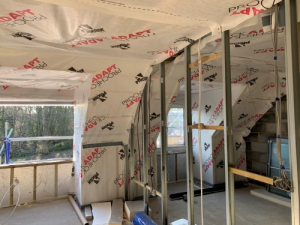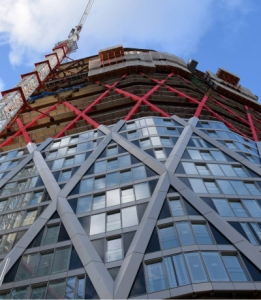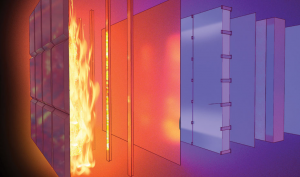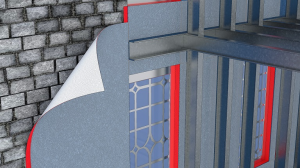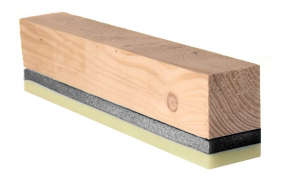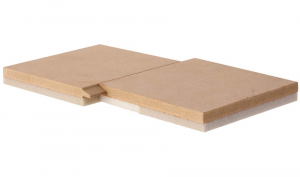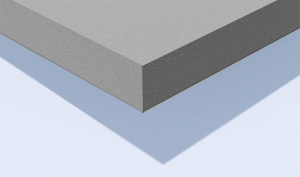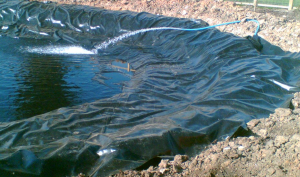A.PROCTOR GROUP LTD
Suppliers of: breather membranes, Insulation Boards, Acoustic Insulation, Vapour Control Membranes, Breather Membrane, Geomembrane, roofing Membranes, Geotextiles, roofing Underlay, Membrane, Acoustic floors, Insulation Board, Floor Insulation, Ground Protection Memb
The A. Proctor Group has, for nearly 50 years, been serving the construction industry with an extensive portfolio of thermal, acoustic and membrane products. The Group provides a wide range of high quality solutions that comply with the continuously evolving requirements of the construction industry. Our commitment to keeping pace with this evolution has led to the group’s expansion, today encompassing five individual divisions.
This diversity gives us the ability to consider buildings holistically, and hence to develop systems that complement each other across a wide range of sectors.
Our close links with the industry, both academics and construction professionals, combined with our broad in house knowledge base gives us the ability to anticipate and create in whichever sectors we choose to compete.
We provide solutions for:
Condensation Control
The A. Proctor Group has been developing vapour permeable membranes and vapour control layers for over 25 years and have condensation control solutions for all areas of the building envelope.
Moisture vapour will pass through the various layers of any construction by both convection and diffusion. The objective is to ensure, by design, that the moisture vapour can disperse to the outside atmosphere without being cooled to below dewpoint temperature, thus eliminating condensation and associated problems such as mould growth.
- Proctor Air® – Next Generation Air & Vapour Permeable Membrane - View Product
- Proctorwrap® - View Product
- Proctorwrap Reflect® - View Product
- Reflectatherm® Plus - View Product
- Procheck® Adapt – Variable Permeability Vapour Control Layer VCL - View Product
- Product Tapes - View Product
- Procheck® 500 - View Product
- Procheck® 125 - View Product
- Procheck® 300 - View Product
- FramePro® W1 - View Product
- Profoil 861 - View Product
Airtightness in Buildings
Our range of Wraptite external air barriers solve the problem of reliably achieving airtightness in buildings, with a robust two component solution comprising Wraptite & Wraptite Tape. This new approach saves on both the labour and material costs associated with meeting the demands of modern energy efficiency requirements in both commercial and residential buildings. Moving the air barrier to the outside of the building, away from the ‘services zone’ means there are far fewer potential penetrations to the air barrier and that there is no requirement for expensive specialist components such as airtight junction boxes, light switches or downlighter hoods. Wraptite is a unique external airtight solution, which is not only highly vapour permeable, yet airtight – but also self-adhered to ensure a consistent airtight external seal.
- Wraptite® – External Self Adhesive Air Tight Membrane - View Product
- Wraptite® UV - View Product
- FramePro® W1 - View Product
Fire Solutions in Buildings
Due to the tragic event at the Grenfell Tower in 2017 and subsequent building fires in the UK, Facades and Fire Safety has, rightly so, elicited increased focus on the fire performance of products used in the constructions of today. It has had a huge impact on the high-rise sector and has resulted in one of the biggest changes in Regulation 7 and Approved Document B (ADB) that has been experienced for a number of years.
- Fireshield® - View more
- Procheck® A2 - View more
- Procheck® FR200 - View more
- Spacetherm® A1 - View more
- Wraptite® – External Self Adhesive Air Tight Membrane - View more
- Façadeshield® UV - View more
- Probreathe® A2 - View more
Thermal Insulation in Buildings
We offer a large range of thermal solutions including Thermal Laminates for roofs, walls and floors, Foam Fabrication, Tapered Roofing and Multi-foil insulation. We have also developed Spacetherm®, a thin aerogel insulation, commonly used for solid wall applications.
- Spacetherm® – Ultra Thin Aerogel Insulation for Retrofit & Newbuild - View Product
- Spacetherm® A1 - View Product
- Spacetherm Wall Liner - View Product
- Spacetherm Wallboard - View Product
- Wraptherm® - View Product
- Spacetherm Multi - View Product
- Spacetherm Directfix - View Product
- Spacetherm Cold Bridge Strip - View Product
- Spacetherm Window Reveal Board - View Product
Acoustic Floor Solutions
Our unrivalled expertise gained by extensive research and development both at our own acoustic laboratory and through the close links we have established with acoustic specialists at Napier, Sheffield Hallam and Heriot-Watt universities has resulted in acoustic floating floor insulation solutions & acoustic floor underlays appropriate to the majority of floor constructions.
Profloor Systems are designed to meet the requirements of the Building Regulations and Robust Details for impact and airborne sound and solutions are available for timber and concrete floors on both new build and refurbishment projects.
- Profloor Dynamic Batten - View Product
- Profloor Micro Deck 17 - View Product
- Profloor Dynamic Deck 26 - View Product
- Profloor Excel Deck 31 - View Product
- Profloor Solo Deck 23 - View Product
- Profloor Excel Batten - View Product
- Profloor Solo Batten - View Product
- Ravatherm™ - View Product
- Plusboard - View Product
- Plusfloor - View Product
Ground Gas Protection
The A. Proctor Group has been in the Gas Protection market for over 20 years promoting a range of gas membranes and venting components for use on contaminated land sites. Adequate protection against the ingress of ground gas and vapours is crucial and the A. Proctor Group can provide safe and value engineered solutions.
- Protech GM Super - View Product
- Protech Radon 400 - View Product
- Protech VOC Flex - View Product
- Provoid - View Product
- Protech GM PP - View Product
- Ground Gas Membrane Accessories - View Product
Further Technical information is available from the BPi Download Library or from the Manufacturer’s own website.
Wraptite® external air barrier helps to create state-of-the-art learning environments
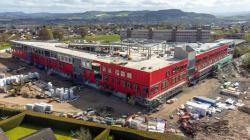 Wraptite® external air barrier helps to create state-of-the-art learning environments for over 4500 Scottish pupils.
Wraptite® external air barrier helps to create state-of-the-art learning environments for over 4500 Scottish pupils.
The specification and installation of A.Proctor Group’s Wraptite® external air barrier is helping three separate secondary school projects in Scotland to achieve the Passivhaus standard. As a result of the high-quality new school buildings, more than 4500 pupils will benefit from learning in thermally comfortable classrooms with excellent indoor air quality.
All three schools are being delivered by main contractor Robertson ConstructionTayside.With its purpose of assuring a sustainable future, Robertson has developed a specialism in Passivhaus construction, which supports its customers, local authorities and Government to address low carbon goals.
What are the three Passivhaus school projects where Wraptite has been specified?
The three schools are Perth High School, East End Community Campus in Dundee, and Monifieth Learning Campus. Construction commenced on all three within the space of a few months in the first half of 2023.
Perth High School was the first project to get underway.The current Oakbank Road building is more than 50 years old and rated ‘poor’ for suitability. It has been used beyond its design life.The new-build school will replace the existing facility when it is handed over in summer 2025.
Originally, a more traditional design and specification was intended for the construction, which will be used by 1600 pupils and 140 staff. The Passivhaus approach was adopted during the design process, and required minimal alteration to the building’s agreed form and location.
Two Dundee high schools also nearing the end of their life – Craigie High School and Braeview Academy – will be replaced by the East End Community Campus. Designed to accommodate around 1800 pupils, the site includes an integrated education centre for those with complex assisted support needs.
Expected to be handed over in summer 2025 as well, the campus’s sports facilities will be available to local groups and clubs. Some council services will be delivered from the new campus too.
The new education and community campus in Monifieth, near Dundee, features a new school for 1200 pupils and amenities including a swimming pool and Sport Scotland-standard athletics facilities. Angus Council’s intention is for the campus to be used fully, all year round.
Like Perth High School, construction is being phased so the new school is constructed while the old one remains in use.The existing facility will then be demolished once the new campus is up and running.
Installing Wraptite external air barrier to a variety of structural solutions
The external walls of each new school are constructed in a slightly different way, showing that the Passivhaus standard can be achieved using different construction methods. Building on and using its sustainable construction expertise, Robertson ensured the standard was capable of being met on these three projects.
“We wanted to take what we learnt delivering Scotland’s first certified Passivhaus school, Riverside Primary, and apply it to future projects,” said Kevin Dickson, Regional Managing Director, Robertson ConstructionTayside.“This opportunity came with the appointment to deliver three Passivhaus schools, constructed to realise each local authority’s vision while generating meaningful benefits throughout the process.”
A similar procurement process to Riverside Primary meant that using Wraptite satisfied the requirement for using local suppliers, on top of the experience gained in using it to meet the airtightness requirements.
Perth High School is a concrete frame with mineral wool insulation and a facing brick facade.The school buildings to the other two campuses feature a mix of concrete and steel frame, with high performance insulation. Facing brickwork is the finish at Monifieth, while East End Community Campus will have finishes of facing brickwork, precast concrete and cladding.
Wraptite is well-suited to Passivhaus projects, and the different construction methods demonstrate its versatility in helping to meet the standard’s high levels of airtightness. By moving the airtight line to the exterior face of the wall structure, it avoids a lot of complex detailing around services and other penetrations that typically occur at the internal face.
As a fully-adhered vapour permeable membrane, Wraptite saves on labour and material costs, without compromising airtightness levels and without increasing condensation risk within the structure. Not all detailing issues can be avoided, of course, and where particular areas of detailing do need to be addressed there is the added benefit of Wraptite tape.
On-site quality checks are a hallmark of the Passivhaus standard and accreditation.The simple solution offered by Wraptite allows those checks to be carried out with the minimum of fuss. Find out more: https://proctorgroup.com/products/wraptite
A. Proctor - Roof underlay specification for retrofit projects
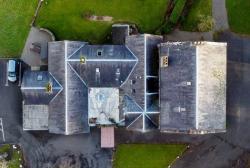 All roof coverings and underlays need to be replaced at some point during a building’s useful life. When that time comes, how can roof membranes help existing buildings to meet current performance requirements and be resilient for the future? Sue Menmuir, Technical Advisor at the A. Proctor Group looks at some of the challenges of retrofitting roofs.
All roof coverings and underlays need to be replaced at some point during a building’s useful life. When that time comes, how can roof membranes help existing buildings to meet current performance requirements and be resilient for the future? Sue Menmuir, Technical Advisor at the A. Proctor Group looks at some of the challenges of retrofitting roofs.
Perhaps the biggest challenge presented by existing buildings is that no two projects are ever the same. The construction method and the quality of the construction, combined with site specific factors that affect exposure to weather, all influence the durability of a roof. Any resulting water ingress will have a further negative impact on lifespan.
Then there are occupancy factors to consider. How people use a building – the way they heat and ventilate it – varies from occupant to occupant. That changes how the building fabric responds to different internal conditions, shortening or prolonging a roof’s service life accordingly.
Retrofitting a roof isn’t just about the roof
Retrofit is all about managing risk. One of the most important things to keep in mind when retrofitting an existing building is that everything is interconnected. This is reinforced in all retrofit guidance, as well as standards like BS 5250:2021 Management of moisture in buildings. Code of practice.
It might be tempting to look at the roof in isolation, but decisions enacted elsewhere will impact on the behaviour of the roof. Making other parts of the building fabric better insulated and more airtight will improve the building’s energy efficiency. But if corresponding improvements to ventilation provision are not made then a build-up of moisture vapour internally could transfer into the roof space.
And improvements carried out to the roof will affect the design and specification of future changes to other parts of the building. Loft insulation is seen as ‘low hanging fruit’ when it comes to retrofit. Often it is the first place that people start when improving the performance of a building, but it carries its own risks for the roof as a whole.
What to consider when making improvements to pitched roofs
Installing loft insulation, or increasing the thickness of any existing loft insulation, is a relatively easy measure to carry out. Homeowners might even consider doing the job themselves to keep costs down. Questions that need to be considered when upgrading loft insulation include the following.
What is the type, age and condition of the existing roof underlay?
Is the roof underlay a traditional high-resistance (HR) membrane, like bitumen felt? If so, is it due (or even overdue) for replacement?
Is it a more modern low-resistance (LR) membrane? If so, it is likely to be relatively new and a complete replacement of the roof covering probably isn’t needed yet. But it is also likely to be an airtight LR membrane, so it allows the passage of moisture vapour but not air.
Making loft insulation thicker has the effect of reducing the temperature of the roof space, because heat loss into the roof is reduced. Typical loft insulation products are vapour permeable, however, so internal moisture can still reach the roof space. Colder air holds less moisture, making condensation more likely within the roof space – even if the underlay is a (LR, airtight) ‘breather membrane.’
How is the roof space ventilated?
Once internal moisture vapour reaches the roof space, it is critical to remove it from the building as quickly as possible. This is where effective roof ventilation comes in, dealing with the increased humidity that comes from making the roof space colder.
Roof space ventilation might be at the eaves only, relying on air movement across the span of the loft. Or it might be at the eaves and ridge, with air flowing up through the roof space. Assessing the existing provision prior to carrying out work is an essential part of responsible roof retrofit.
A significant issue with upgrading loft insulation is whether it can be installed without blocking existing eaves ventilation. The counter-issue to keeping ventilation pathways clear is making sure that gaps around the perimeter of the roof don’t act as a route for warm air to escape from occupied rooms below.
Proctor Air an air permeable LR membrane ideal for retrofit projects
Because every retrofit project is different, performance targets and available budgets are different, dictating the scope of work that can be carried out. Nevertheless, the overarching aim of many retrofits, and especially deep retrofits, is to prepare existing buildings for the future.
That’s where A. Proctor Group’s pitched roof underlay comes in: Proctor Air.
As an air permeable (rather than airtight) LR underlay – or APLR – no vapour control layer is required in the ceiling. And no ventilation measures are required in the cold roof space, so insulation can be installed right into the eaves with no risk of blocking ventilation.
Proctor Air permits the passage of both air and moisture vapour through the roof construction, providing a more uniform flow of air than normal vents. Condensation risk in the roof space is therefore removed.
When a new roofing system is installed, there is an inevitable period of time where the underlay is in place without the roof covering to protect it. Even though membranes are classed as secondary protection, the underlay temporarily bears the brunt of any inclement weather. Its ability to do that is particularly critical in retrofit scenarios where the building is likely to still be in use.
Proctor Air’s water resistance has been tested and meets the threshold of over 1m of water holdout recommended in the NFRC’s Technical Bulletin TB06. However, consideration should be given to protection of the roof during inclement weather.
The A. Proctor Group is a 4th generation family business with a history of technical innovation, promoting good practice, and developing products that roofing contractors want to use. We have applied this wealth of experience to creating the air permeable LR membrane, Proctor Air.
All of this is backed by our 15-year warranty, offering peace of mind even in the face of an uncertain future climate.






